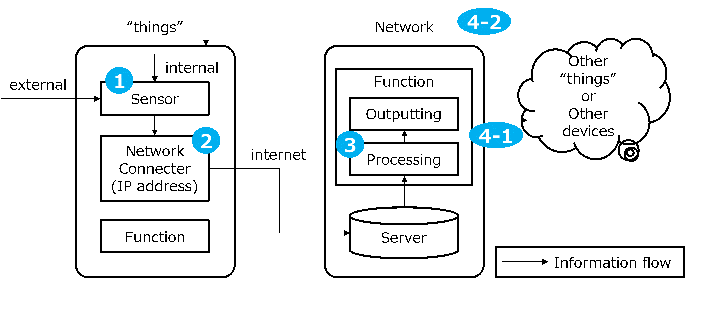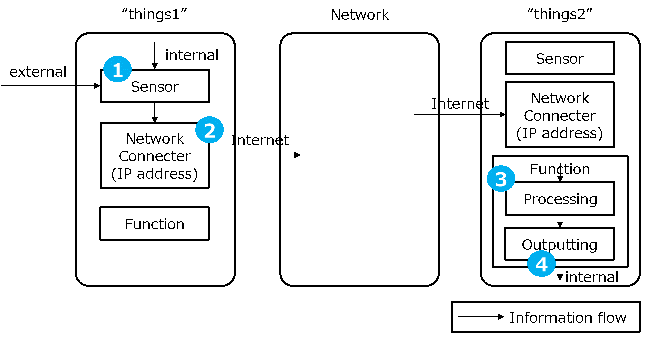G16Y
Definition
Diese Klassifikationsstelle umfasst:Aspekte mit Bezug zu IdD.
In dieser Unterklasse ist IdD definiert als System, das die folgenden vier Prozesse ausführt:
(1) Physische Objekte (die ” Dinge”), verbunden mit einem Netzwerk, erfassen und sammeln Informationen von ihrem internen Zustand oder ihrer äußeren Umgebung.
(2) Die durch die Objekte erfassten und gesammelten Informationen werden an ein Netzwerk gesendet.
(3) Die Informationen werden im Netzwerk verarbeitet.
(4) Die durch Informationsverarbeitung erhaltenen Ergebnisse werden zu den Objekten (den ” Dingen”) oder anderen Objekten (” Dingen”) oder Einrichtungen zurückgemeldet.
Mit anderen Worten: IdD ist definiert als ein System, das aus drei Hauptkomponenten besteht: (a) physische Objekte (” Dinge”), (b) Netzwerk und (c) Funktion, wie im Glossar angegeben.
Siehe die unten abgebildeten Beispiele.
Erläuternde Abbildung von IdD mit Server

① Physische Objekte (die ” Dinge”) erfassen und sammeln Informationen.
② Die Dinge haben IP-Adressen und senden die Informationen über das Internet an einen Server.
③ Im Netzwerk werden die Informationen verarbeitet.
④ Das Ergebnis der Informationsverarbeitung wird an die Dinge (4-2) zurückgemeldet oder an andere Dinge oder Einrichtungen (4-1) ausgegeben.
Erläuternde Abbildung von IdD ohne Server

① Physische Objekte (die ” Dinge”) erfassen und sammeln Informationen.
② Die Dinge haben IP-Adressen und senden die Informationen über das Internet an andere Objekte (andere ” Dinge”).
③ Die anderen Dinge verarbeiten die Informationen.
④ Das Ergebnis der Informationsverarbeitung wird von den anderen Dingen genutzt.
Erläuternde Abbildung von IdD mit Hub

① Physische Objekte (die ” Dinge”) erfassen und sammeln Informationen.
② Die Dinge haben keine IP-Adressen und senden die Informationen mittels eines Hub über das Internet an andere Objekte (andere ” Dinge”).
③ Die anderen Dinge verarbeiten die Informationen.
④ Das Ergebnis der Informationsverarbeitung wird von den anderen Dingen genutzt.
Glossar
Objekt
| Objekte (die “Dinge”) sind in Technologie eingebettet, die es diesen Objekten ermöglicht, Informationen zu erfassen und zu sammeln und eine Verbindung zum Netzwerk herzustellen.
Beispiele hierfür sind:
- Objekte, die bestimmte Funktionen mit wenigen oder keinen elektronischen Komponenten ausführen, z.B. Fenster, Türen oder Kleidung.
- Objekte, die elektronische Komponenten enthalten, die Funktionen ausführen, unabhängig von denen, mit denen sie die Verbindung mit dem Netzwerk ausführen, z.B. elektronische Haushaltsgeräte und Fahrzeuge.
Dagegen werden allgemeine Rechen- und Kommunikationsgeräte, z.B. Computer oder Laptop, allein nicht als Objekte betrachtet. Wenn diese Geräte jedoch in physische Objekte eingebettet sind und es den Objekten ermöglichen, Informationen zu erfassen und zu sammeln und sich mit dem Netzwerk zu verbinden, dann können die Geräte als Teil von Objekten (den ”Dingen”) betrachtet werden. Zum Beispiel können Smartphones, die an Fahrzeugen angebracht sind, um Positionsdaten zu erfassen und an einen Server zu liefern, als Teil der Objekte betrachtet werden.
|
Ding
| Siehe “Objekt”
|
Netzwerk
| Kommunikationssystem verbundener Objekte, die eigene IP-Adressen haben.
Dagegen wird ein Kommunikationssystem ohne Verwendung von IP-Adressen, z.B. die drahtlose Nahbereichskommunikation über NFC oder Bluetooth®, in dieser Unterklasse nicht als Netzwerk betrachtet.
|
Funktion
| Informationsverarbeitung und Ausgabe der durch die Informationsverarbeitung erhaltenen Ergebnisse.
Informationsverarbeitung enthält hier:
- komplexe Informationsverarbeitung, wie z.B. die Analyse von Eingangsinformationen, z.B. Datenanalyse.
- komplexe Informationsverarbeitung, wie z.B. die Erstellung von Steuerinformationen aus Eingangsinformationen.
Informationsverarbeitung enthält hier nicht:
- einfache oder weniger komplexe Informationsverarbeitung, wie z.B. nur die Aufzeichnung von Eingangsinformationen ohne Datenanalyse, z.B. Sicherheitskamerasysteme.
- einfache oder weniger komplexe Informationsverarbeitung, wie z.B. nur die Übermittlung von Steuerinformationen zur Bedienung von Geräten, z.B. Fernsteuerungssysteme.
|
G16Y
Definition Statement
This place covers:IoT related aspects.
In this subclass, IoT is defined as a system that executes the following four processes.
(1) Physical objects (the ”things”) connected to a network sense and collect information from their internal state or external environment.
(2) The information sensed and collected by the objects is sent to a network space.
(3) The information is processed in the network space.
(4) The results obtained by information processing are fed back to the objects (the ”things”) or are output to other objects (other ”things”) or devices.
In other words, IoT is defined as a system consisted of three main components, namely: (a) physical objects (”things”), (b) network and (c) function, as defined in the Glossary.
See illustrative examples below.
Illustrative image of IoT with server

① Physical objects (the ”things”) sense and collect information.
② The objects have IP address and send the information to a server through internet.
③ In the network space, the information is processed.
④ The result of information processing is fed back to the objects (4-2) or output to other objects or other devices (4-1).
Illustrative image of IoT without server

① Physical objects (the ”things”) sense and collect information.
② The objects have IP address and send the information to other objects (other ”things”) through internet.
③ The other objects process the information.
④ The result of information processing is used by the other objects.
Illustrative image of IoT with HUB

① Physical objects (the ”things”) sense and collect information.
② The objects don’t have IP address and send the information to other objects (other ”things”) through internet via HUB.
③ The other objects process the information.
④ The result of information processing is used by the other objects.
Glossary
object
objects
“object”
“objects”
| Objects (the “things”) are embedded with technology enabling these objects to sense and collect information and connecting to network. Examples of such objects are:
- Objects, which perform specific functions with little or no electronic components, e.g. windows, doors or clothes.
- Objects, which include electronic components that perform specific functions independently from their functions for connecting to network, e.g. home electronic appliance and vehicles.
On the other hand, generic computing and communicating devices, e.g. computer or laptop, on their own are not regarded as objects. However, in case that these devices are embedded in physical objects and enable the objects to sense and collect information and connect to network, then the devices can be regarded as a part of objects (the ”things”). For example, smartphones, which are attached to vehicles to sense and deliver position data to a server, can be regarded as part of the objects.
|
thing
things
"thing"
"things"
| see “object”
|
network
networks
| means the communication system of interconnected objects which have their own IP addresses. A typical example of such network is the Internet.
On the other hand, communication system without using IP addresses, e.g. short-range wireless communication via NFC or Bluetooth®, is not regarded as a network in this subclass.
|
function
functions
| means processing information and outputting the results obtained by information processing.
Processing information, here, includes:
- Complex information processing such as analyzing input information, e.g. data analysis.
- Complex information processing such as creating control information from input information.
Processing information, here, doesn’t include:
- Simple or less complex information processing such as only monitoring input information without data analysis, e.g. security camera system.
- Simple or less complex information processing such as only conveying control information to operate device, e.g. remote control system.
|